engine TOYOTA PRIUS 2022 Owners Manual
[x] Cancel search | Manufacturer: TOYOTA, Model Year: 2022, Model line: PRIUS, Model: TOYOTA PRIUS 2022Pages: 744, PDF Size: 14.35 MB
Page 5 of 744
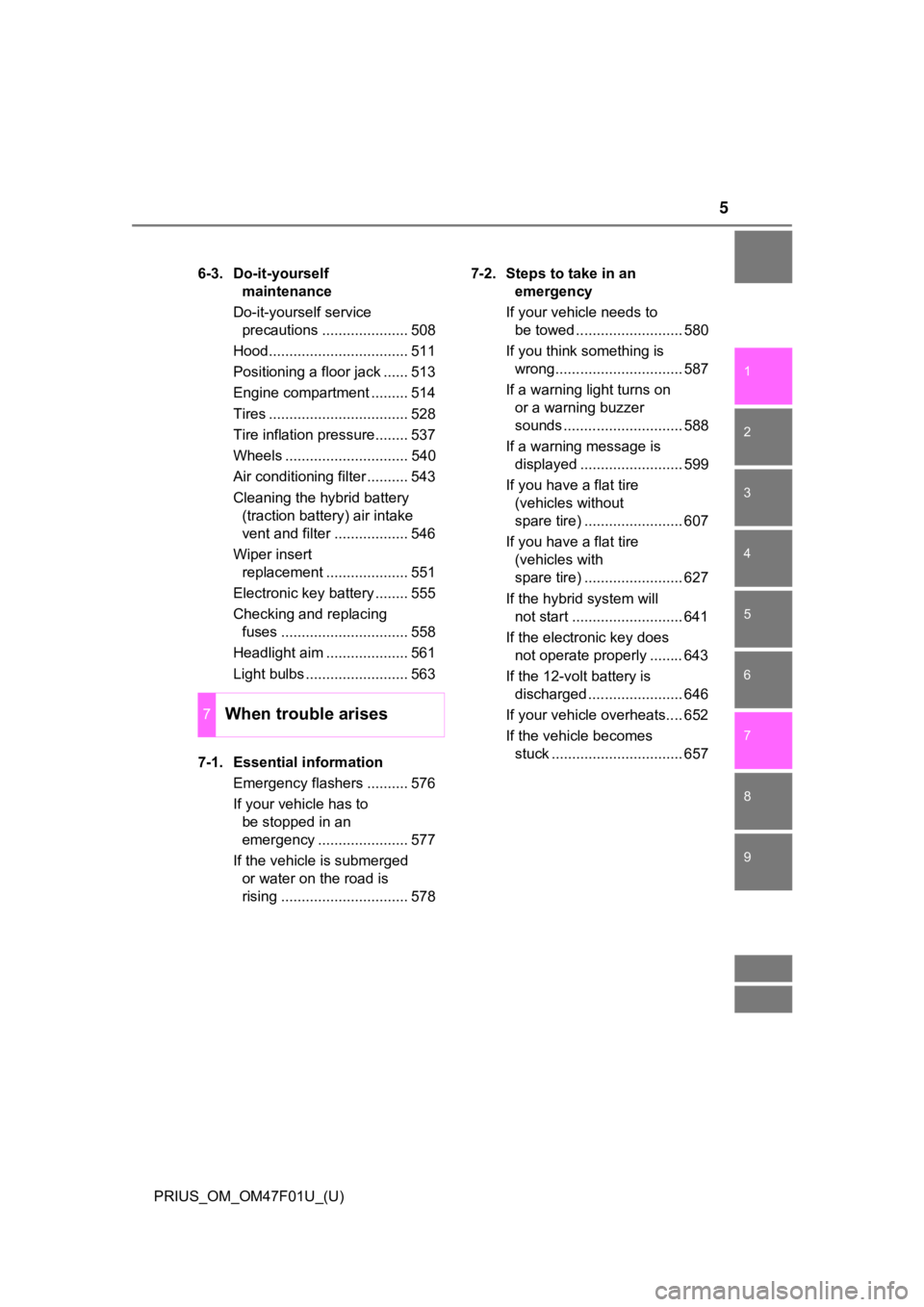
5
1
9 8
7
6 4 3
2
PRIUS_OM_OM47F01U_(U)
5
6-3. Do-it-yourself maintenance
Do-it-yourself service precautions ..................... 508
Hood.................................. 511
Positioning a floor jack ...... 513
Engine compartment ......... 514
Tires .................................. 528
Tire inflation pressure........ 537
Wheels .............................. 540
Air conditioning filter .......... 543
Cleaning the hybrid battery (traction battery) air intake
vent and filter .................. 546
Wiper insert replacement .................... 551
Electronic key battery ........ 555
Checking and replacing fuses ............................... 558
Headlight aim .................... 561
Light bulbs ......................... 563
7-1. Essential information Emergency flashers .......... 576
If your vehicle has to be stopped in an
emergency ...................... 577
If the vehicle is submerged or water on the road is
rising ............................... 578 7-2. Steps to take in an
emergency
If your vehicle needs to be towed .......................... 580
If you think something is wrong............................... 587
If a warning light turns on or a warning buzzer
sounds ............................. 588
If a warning message is displayed ......................... 599
If you have a flat tire (vehicles without
spare tire) ........................ 607
If you have a flat tire (vehicles with
spare tire) ........................ 627
If the hybrid system will not start ........................... 641
If the electronic key does not operate properly ........ 643
If the 12-volt battery is discharged ....................... 646
If your vehicle overheats.... 652
If the vehicle becomes stuck ................................ 657
7When trouble arises
Page 10 of 744
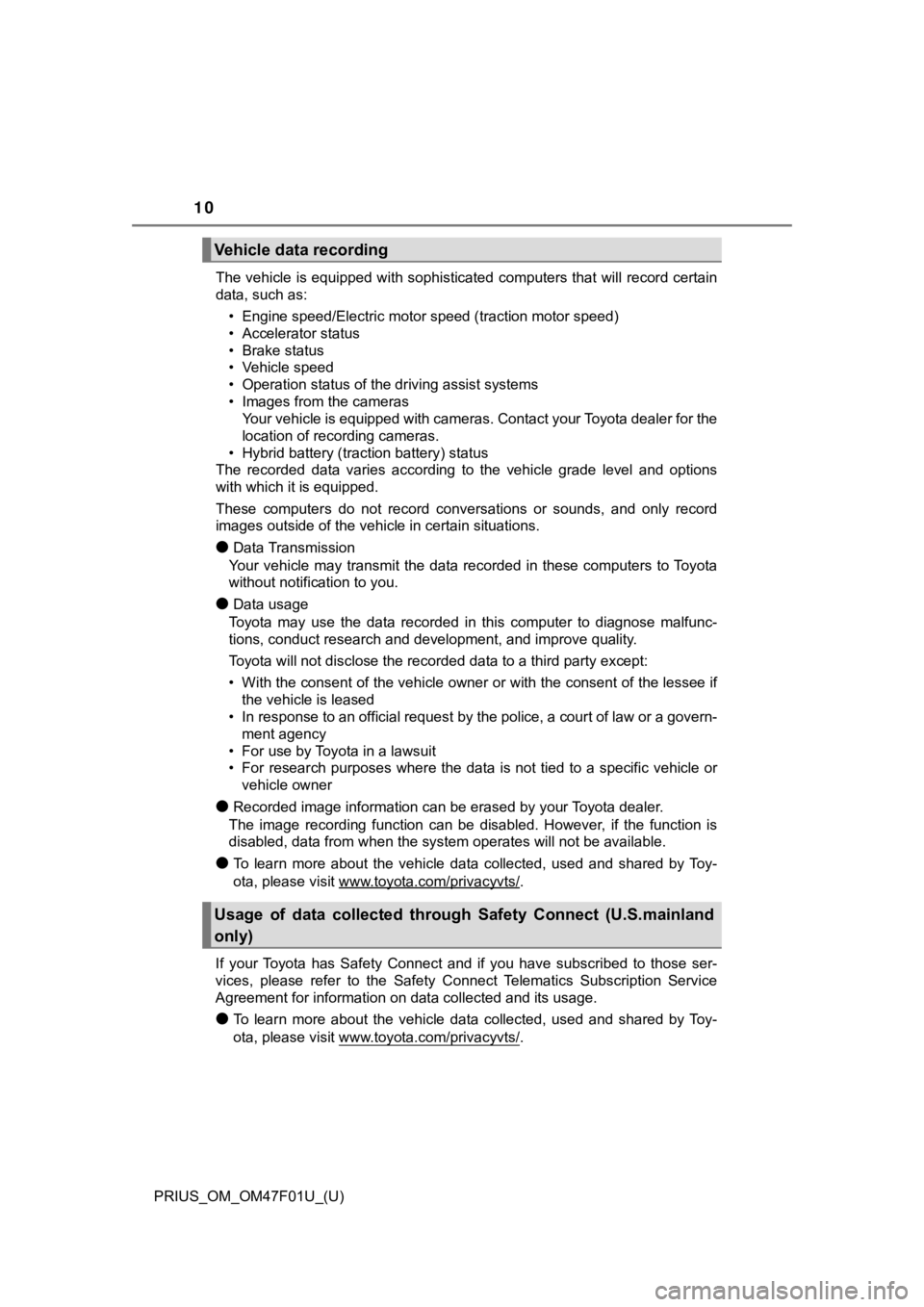
10
PRIUS_OM_OM47F01U_(U)The vehicle is equipped with sophisticated computers that will
record certain
data, such as:
• Engine speed/Electric motor speed (traction motor speed)
• Accelerator status
• Brake status
• Vehicle speed
• Operation status of the driving assist systems
• Images from the cameras Your vehicle is equipped with cameras. Contact your Toyota deal er for the
location of recording cameras.
• Hybrid battery (traction battery) status
The recorded data varies according to the vehicle grade level and options
with which it is equipped.
These computers do not record conversations or sounds, and only record
images outside of the vehicle in certain situations.
●Data Transmission
Your vehicle may transmit the data recorded in these computers to Toyota
without notification to you.
●Data usage
Toyota may use the data recorded in this computer to diagnose m alfunc-
tions, conduct research and development, and improve quality.
Toyota will not disclose the recorded data to a third party exc ept:
• With the consent of the vehicle owner or with the consent of the lessee if the vehicle is leased
• In response to an official request by the police, a court of l aw or a govern-
ment agency
• For use by Toyota in a lawsuit
• For research purposes where the data is not tied to a specific vehicle or
vehicle owner
●Recorded image information can be erased by your Toyota dealer.
The image recording function can be disabled. However, if the f unction is
disabled, data from when the system operates will not be available.
●To learn more about the vehicle data collected, used and shared by Toy-
ota, please visit www.toyota.com/privacyvts/
.
If your Toyota has Safety Connect and if you have subscribed to those ser-
vices, please refer to the Safety Connect Telematics Subscription Service
Agreement for information on data collected and its usage.
●To learn more about the vehicle data collected, used and shared by Toy-
ota, please visit www.toyota.com/privacyvts/
.
Vehicle data recording
Usage of data collected thr ough Safety Connect (U.S.mainland
only)
Page 17 of 744
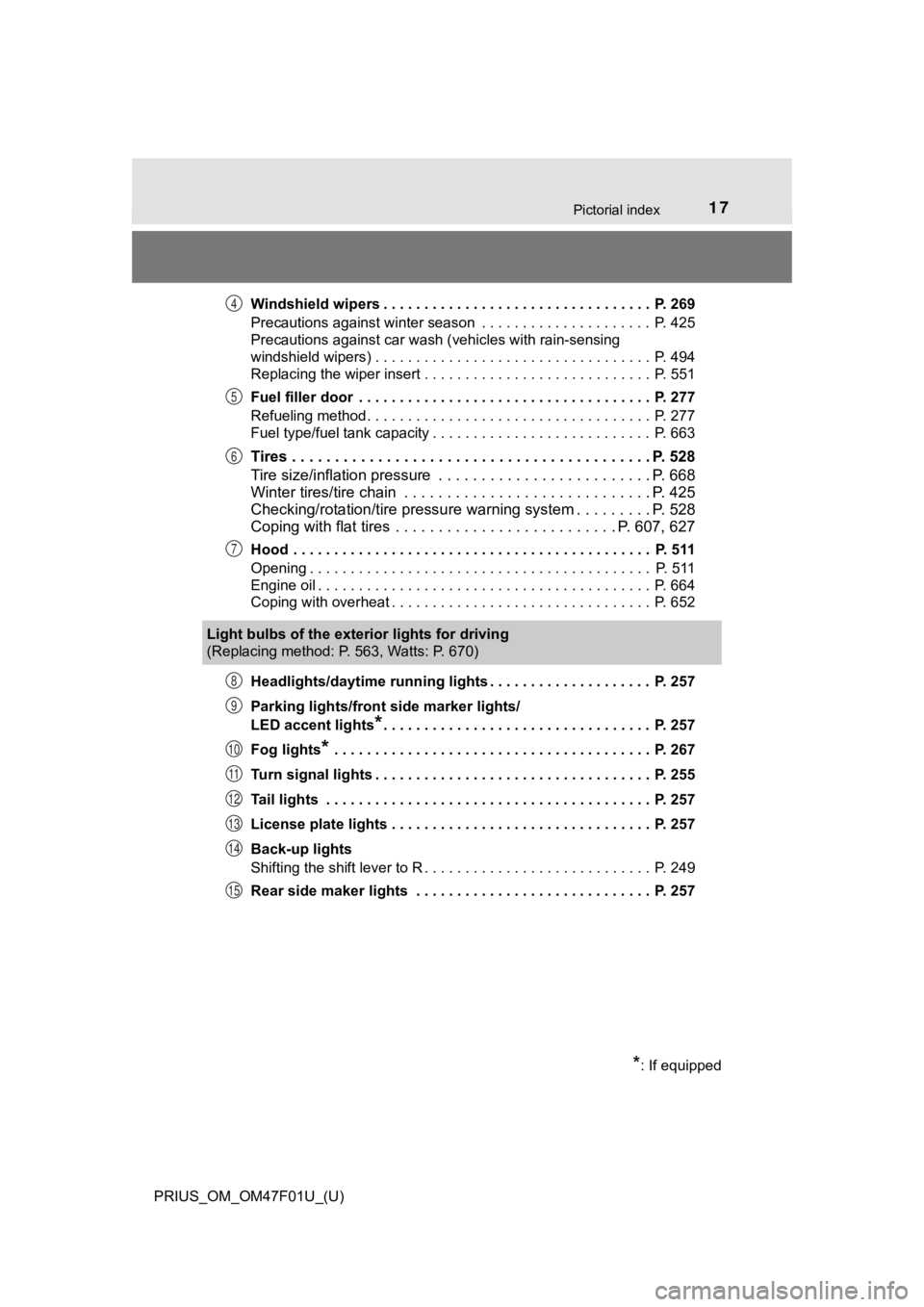
17Pictorial index
PRIUS_OM_OM47F01U_(U)Windshield wipers . . . . . . . . . . . . . . . . . . . . . . . . . . . . . . . . . P. 269
Precautions against winter season . . . . . . . . . . . . . . . . . . . . . P. 425
Precautions against car wash (vehicles with rain-sensing
windshield wipers) . . . . . . . . . . . . . . . . . . . . . . .
. . . . . . . . . . . P. 494
Replacing the wiper insert . . . . . . . . . . . . . . . . . . . . . . . . . . . . P. 551
Fuel filler door . . . . . . . . . . . . . . . . . . . . . . . . . . . . . . . . . . . . P. 277
Refueling method . . . . . . . . . . . . . . . . . . . . . . . . . . . . . . . . . . . P. 277
Fuel type/fuel tank capacity . . . . . . . . . . . . . . . . . . . . . . . . . . . P. 663
Tires . . . . . . . . . . . . . . . . . . . . . . . . . . . . . . . . . . . . . . . . . . P. 528
Tire size/inflation pressure . . . . . . . . . . . . . . . . . . . . . . . . . P. 668
Winter tires/tire chain . . . . . . . . . . . . . . . . . . . . . . . . . . . . . P. 425
Checking/rotation/tire pressur e warning system . . . . . . . . .P. 528
Coping with flat tires . . . . . . . . . . . . . . . . . . . . . . . . . . P. 607, 627
Hood . . . . . . . . . . . . . . . . . . . . . . . . . . . . . . . . . . . . . . . . . . . . P. 511
Opening . . . . . . . . . . . . . . . . . . . . . . . . . . . . . . . . . . . . . . . . . . P. 511
Engine oil . . . . . . . . . . . . . . . . . . . . . . . . . . . . . . . . . . . . . . . . . P. 664
Coping with overheat . . . . . . . . . . . . . . . . . . . . . . . . . . . . . . . . P. 652
Headlights/daytime running lights . . . . . . . . . . . . . . . . . . . . P. 257
Parking lights/front side marker lights/
LED accent lights
*. . . . . . . . . . . . . . . . . . . . . . . . . . . . . . . . . P. 257
Fog lights
* . . . . . . . . . . . . . . . . . . . . . . . . . . . . . . . . . . . . . . . P. 267
Turn signal lights . . . . . . . . . . . . . . . . . . . . . . . . . . . . . . . . . . P. 255
Tail lights . . . . . . . . . . . . . . . . . . . . . . . . . . . . . . . . . . . . . . . . P. 257
License plate lights . . . . . . . . . . . . . . . . . . . . . . . . . . . . . . . . P. 257
Back-up lights
Shifting the shift lever to R . . . . . . . . . . . . . . . . . . . . . . . . . . . . P. 249
Rear side maker lights . . . . . . . . . . . . . . . . . . . . . . . . . . . . . P. 257
4
5
6
7
Light bulbs of the exterior lights for driving
(Replacing method: P. 563, Watts: P. 670)
*: If equipped
8
9
10
11
12
13
14
15
Page 43 of 744
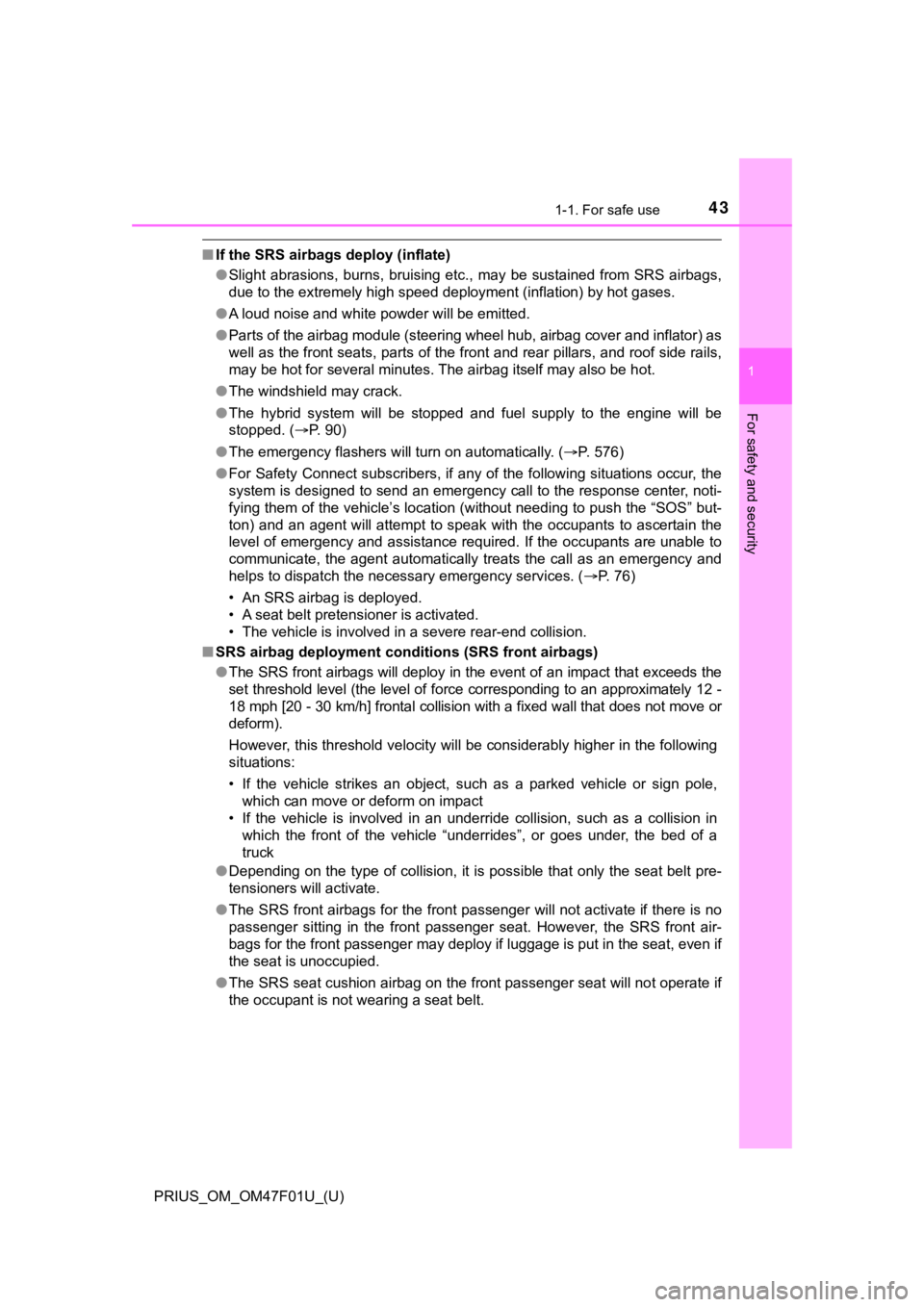
431-1. For safe use
PRIUS_OM_OM47F01U_(U)
1
For safety and security
■If the SRS airbags deploy (inflate)
●Slight abrasions, burns, bruising etc., may be sustained from S RS airbags,
due to the extremely high speed deployment (inflation) by hot g ases.
● A loud noise and white powder will be emitted.
● Parts of the airbag module (steering wheel hub, airbag cover an d inflator) as
well as the front seats, parts of the front and rear pillars, and roof side rails,
may be hot for several minutes. The airbag itself may also be h ot.
● The windshield may crack.
● The hybrid system will be stopped and fuel supply to the engine will be
stopped. ( P. 90)
● The emergency flashers will turn on automatically. ( P. 576)
● For Safety Connect subscribers, if any of the following situations occur, the
system is designed to send an emergency call to the response center, noti-
fying them of the vehicle’s location (without needing to push t he “SOS” but-
ton) and an agent will attempt to speak with the occupants to a scertain the
level of emergency and assistance required. If the occupants are unable to
communicate, the agent automatically treats the call as an emer gency and
helps to dispatch the necessary emergency services. ( P. 76)
• An SRS airbag is deployed.
• A seat belt pretensioner is activated.
• The vehicle is involved in a severe rear-end collision.
■ SRS airbag deployment condi tions (SRS front airbags)
● The SRS front airbags will deploy in the event of an impact tha t exceeds the
set threshold level (the level of force corresponding to an app roximately 12 -
18 mph [20 - 30 km/h] frontal collision with a fixed wall that does not move or
deform).
However, this threshold velocity will be considerably higher in the following
situations:
• If the vehicle strikes an object, such as a parked vehicle or sign pole,
which can move or deform on impact
• If the vehicle is involved in an underride collision, such as a collision in
which the front of the vehicle “underrides”, or goes under, the bed of a
truck
● Depending on the type of collision, it is possible that only th e seat belt pre-
tensioners will activate.
● The SRS front airbags for the front passenger will not activate if there is no
passenger sitting in the front passenger seat. However, the SRS front air-
bags for the front passenger may deploy if luggage is put in the seat, even if
the seat is unoccupied.
● The SRS seat cushion airbag on the front passenger seat will not operate if
the occupant is not wearing a seat belt.
Page 84 of 744

841-4. Hybrid system
PRIUS_OM_OM47F01U_(U)
Hybrid system features
The illustration is an example for explanation and may differ from the
actual item.
Gasoline engine
Front electric motor (traction motor)
Rear electric motor (traction motor)
*
*
: AWD models only
Your vehicle is a hybrid vehicle. It has characteristics differ ent
from conventional vehicles. Be sure you are closely familiar wi th
the characteristics of your veh icle, and operate it with care.
The hybrid system combines the use of a gasoline engine and
an electric motor (traction motor) according to driving condi-
tions, improving fuel efficien cy and reducing exhaust emis-
sions.
1
2
3
Page 85 of 744

851-4. Hybrid system
PRIUS_OM_OM47F01U_(U)
1
For safety and security
◆When stopped/during start off
The gasoline engine stops
* when the vehicle is stopped. During
start off, the electric motor (traction motor) drives the vehic le. At
slow speeds or when traveling down a gentle slope, the engine i s
stopped
* and the electric motor (tr action motor) is used.
When shift position is in N, the hybrid battery (traction batte ry) is not
being charged.
*: When the hybrid battery (traction battery) requires charging o r the engine
is warming up, etc., the gasoline engine will not automatically stop.
( P. 87)
◆During normal driving
The gasoline engine is predominantly used. The electric motor
(traction motor) charges the hybr id battery (traction battery) as nec-
essary.
◆When accelerating sharply
When the accelerator pedal is depressed heavily, the power of t he
hybrid battery (traction battery) is added to that of the gasol ine
engine via the electric motor (traction motor).
◆When braking (regenerative braking)
The wheels operate the electric motor (traction motor) as a pow er
generator, and the hybrid battery (traction battery) is charged.
When driving with the gasolin e engine stopped, a sound, which
changes in accordance with the driving speed, will be played in order
to warn people nearby of the vehicle’s approach. The sound will stop
when the vehicle speed exceeds approximately 22 mph (35 km/h).
Vehicle proximity notification system
Page 86 of 744
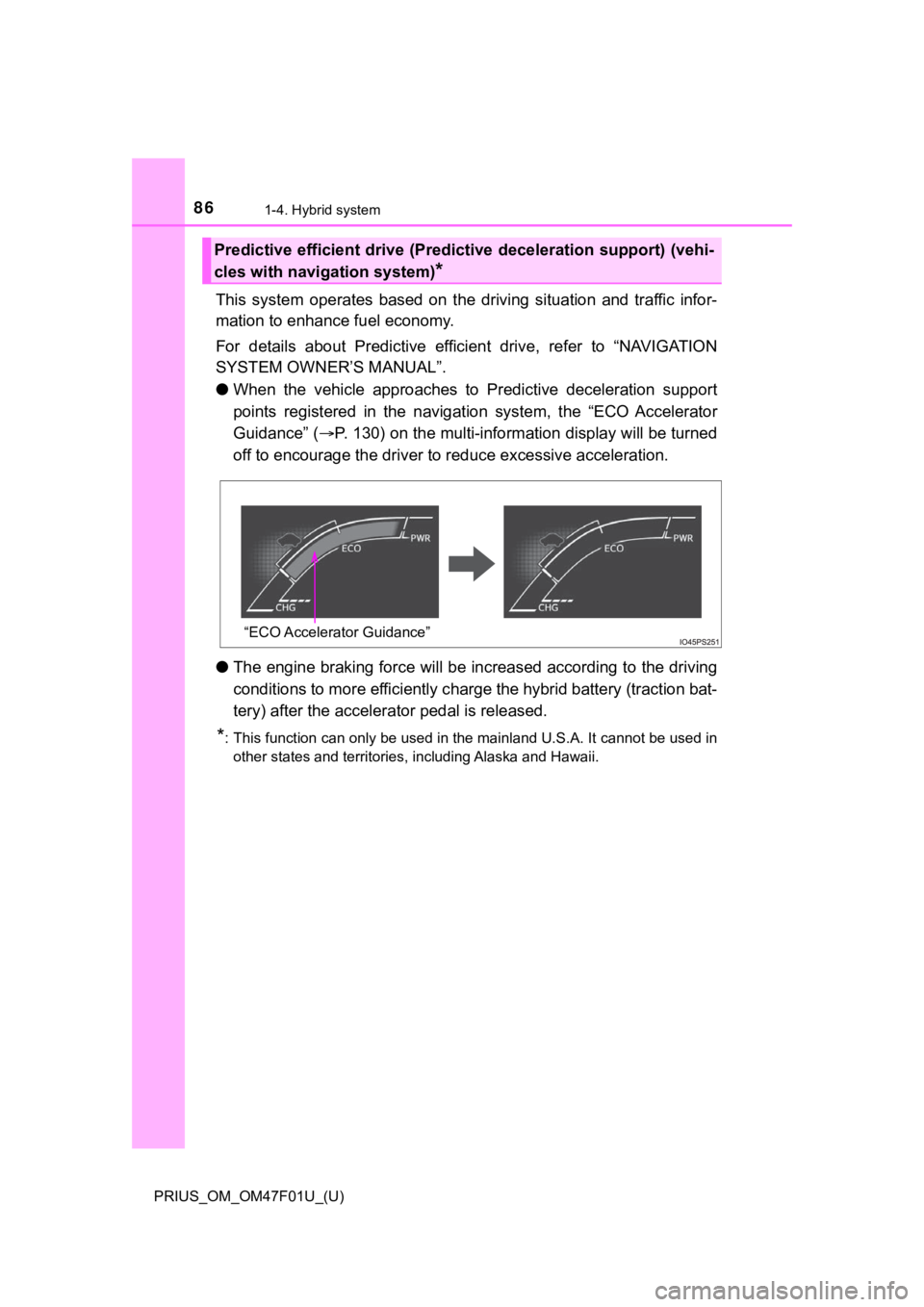
861-4. Hybrid system
PRIUS_OM_OM47F01U_(U)
This system operates based on the driving situation and traffic infor-
mation to enhance fuel economy.
For details about Predictive efficient drive, refer to “NAVIGAT ION
SYSTEM OWNER’S MANUAL”.
● When the vehicle approaches to Pr edictive deceleration support
points registered in the navigat ion system, the “ECO Accelerator
Guidance” ( P. 130) on the multi-information display will be turned
off to encourage the dr iver to reduce excessive acceleration.
● The engine braking force will be increased according to the dri ving
conditions to more efficiently c harge the hybrid battery (traction bat-
tery) after the accelera tor pedal is released.
*: This function can only be used in the mainland U.S.A. It cann ot be used in
other states and territories, including Alaska and Hawaii.
Predictive efficient drive (Pre dictive deceleration support) (v ehi-
cles with navigation system)
*
“ECO Accelerator Guidance”
Page 87 of 744

871-4. Hybrid system
PRIUS_OM_OM47F01U_(U)
1
For safety and security
■Regenerative braking
In the following situations, kinetic energy is converted to electric energy and
deceleration force can be obtained in conjunction with the rech arging of the
hybrid battery (traction battery).
● The accelerator pedal is released while driving with the shift position in D or
B.
● The brake pedal is depressed while driving with the shift posit ion in D or B.
■ Hybrid System Indicator
■ Conditions in which the gasoline engine may not stop
The gasoline engine starts and stops automatically. However, it may not stop
automatically in the following conditions
*:
● During gasoline engine warm-up
● During hybrid battery (traction battery) charging
● When the temperature of the hybrid battery (traction battery) is high or low
● When the heater is switched on
*: Depending on the circumstances, the gasoline engine may also not stop
automatically in situations other than those above.
■ Charging the hybrid batt ery (traction battery)
As the gasoline engine charges the hybrid battery (traction bat tery), the bat-
tery does not need to be charged from an outside source. Howeve r, i f t h e
vehicle is left parked for a long time the hybrid battery (trac tion battery) will
slowly discharge. For this reason, be sure to drive the vehicle at least once
every few months for at least 30 minutes or 10 miles (16 km). I f the hybrid
battery (traction battery) becomes fully discharged and you are unable to start
the hybrid system, contact your Toyota dealer.
■ Charging the 12-volt battery
P. 648
■ After the 12-volt battery has discharged or when the terminal h as been
removed and installed during exchange, etc.
The gasoline engine may not stop even if the vehicle is being driven by the
hybrid battery (traction battery). If this continues for a few days, contact your
Toyota dealer. Hybrid System Indicator represents the
hybrid system power output and regener-
ative charging. ( P. 129)
Page 88 of 744
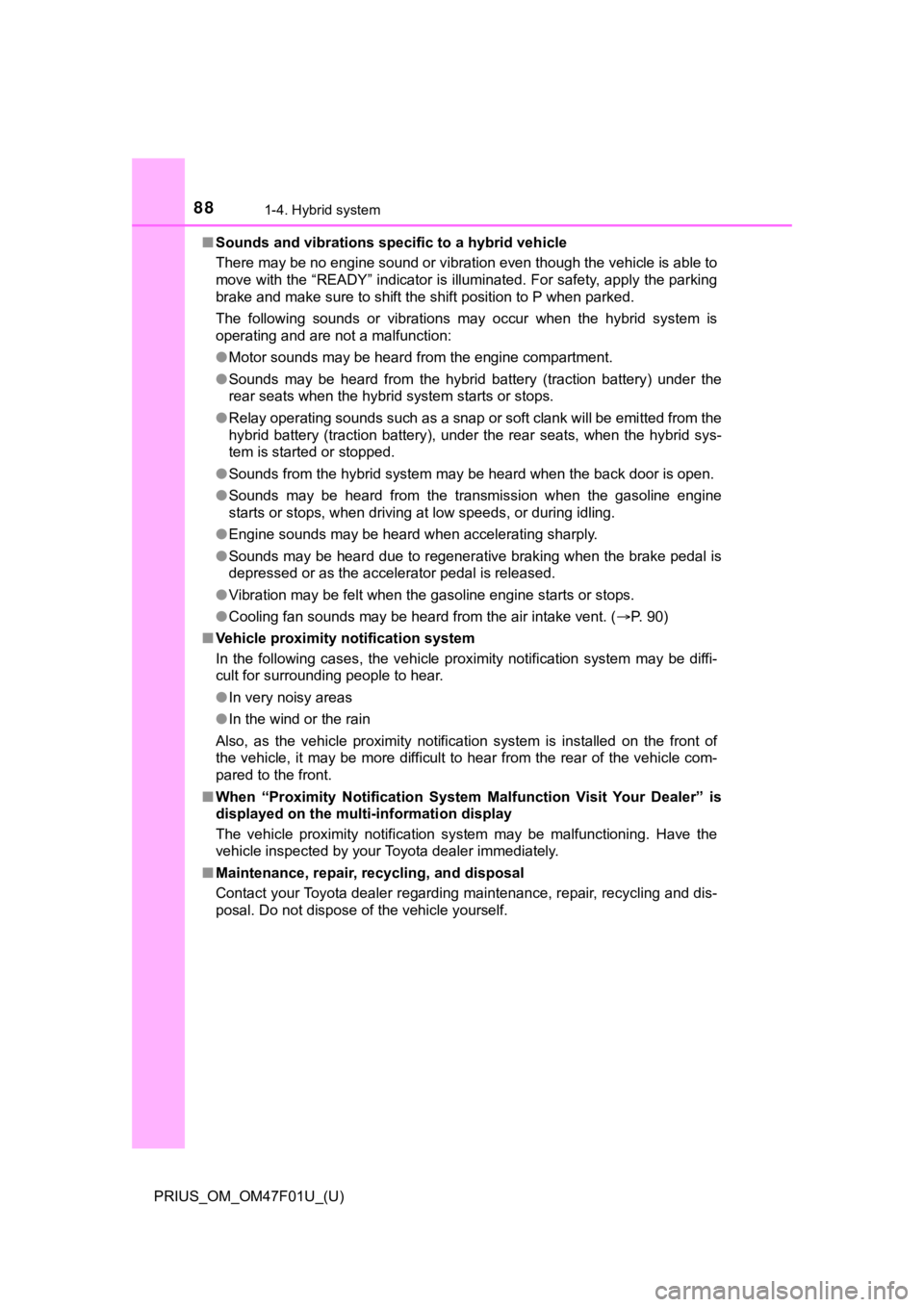
881-4. Hybrid system
PRIUS_OM_OM47F01U_(U)■
Sounds and vibrations sp ecific to a hybrid vehicle
There may be no engine sound or vibration even though the vehic le is able to
move with the “READY” indicator is illuminated. For safety, app ly the parking
brake and make sure to shift the shift position to P when parke d.
The following sounds or vibrations may occur when the hybrid sy stem is
operating and are not a malfunction:
● Motor sounds may be heard from the engine compartment.
● Sounds may be heard from the hybrid battery (traction battery) under the
rear seats when the hybrid system starts or stops.
● Relay operating sounds such as a snap or soft clank will be emi tted from the
hybrid battery (traction battery), under the rear seats, when the hybrid sys-
tem is started or stopped.
● Sounds from the hybrid system may be heard when the back door is open.
● Sounds may be heard from the transmission when the gasoline engine
starts or stops, when driving at low speeds, or during idling.
● Engine sounds may be heard when accelerating sharply.
● Sounds may be heard due to regenerative braking when the brake pedal is
depressed or as the accelerator pedal is released.
● Vibration may be felt when the gasoline engine starts or stops.
● Cooling fan sounds may be heard from the air intake vent. ( P. 90)
■ Vehicle proximity notification system
In the following cases, the vehicle proximity notification syst em may be diffi-
cult for surrounding people to hear.
● In very noisy areas
● In the wind or the rain
Also, as the vehicle proximity notification system is installed on the front of
the vehicle, it may be more difficult to hear from the rear of the vehicle com-
pared to the front.
■ When “Proximity Notification Syst em Malfunction Visit Your Dealer” is
displayed on the multi-information display
The vehicle proximity notification system may be malfunctioning . Have the
vehicle inspected by your Toyota dealer immediately.
■ Maintenance, repair, recycling, and disposal
Contact your Toyota dealer regarding maintenance, repair, recyc ling and dis-
posal. Do not dispose of the vehicle yourself.
Page 108 of 744
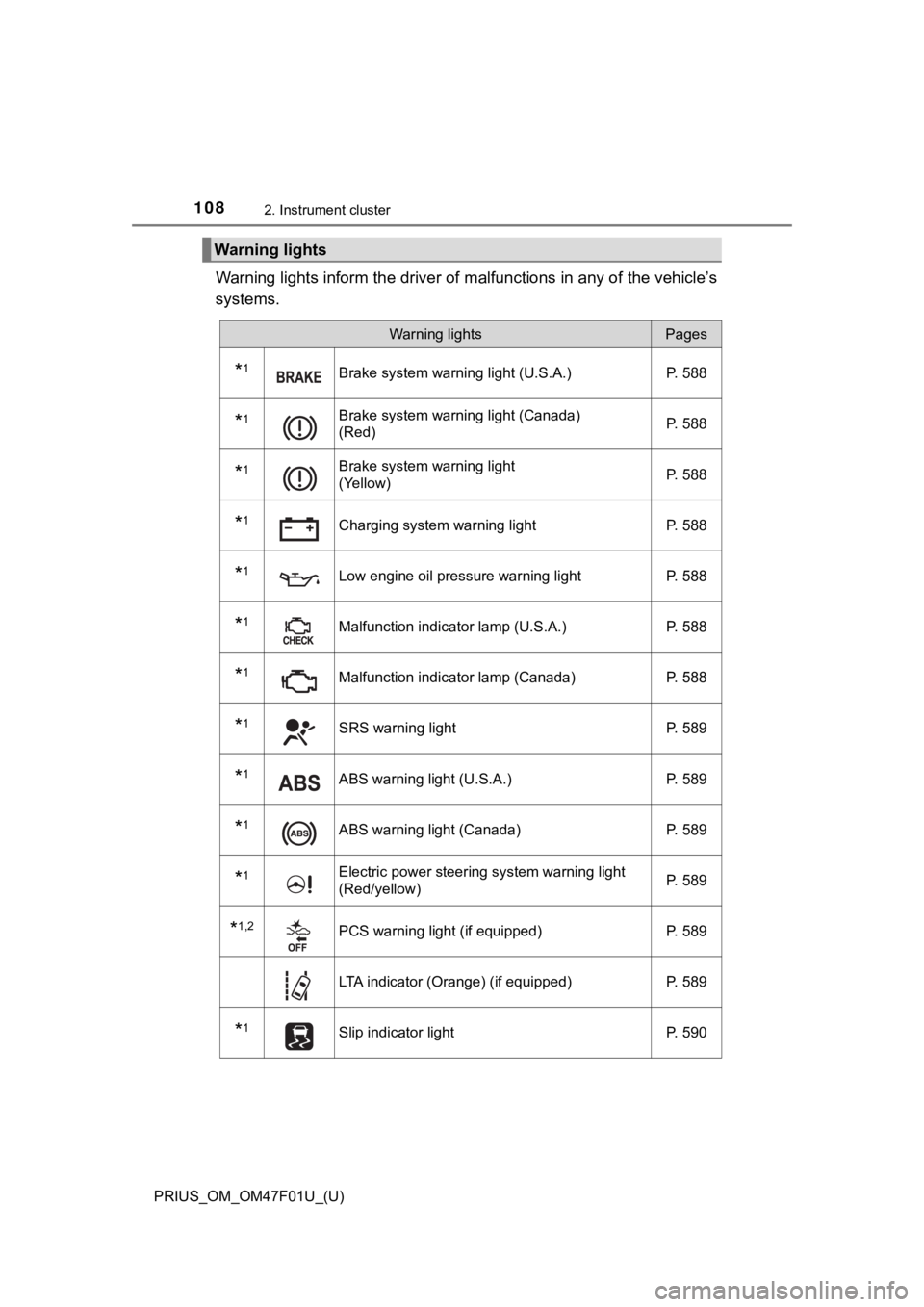
108
PRIUS_OM_OM47F01U_(U)
2. Instrument cluster
Warning lights inform the driver of malfunctions in any of the vehicle’s
systems.
Warning lights
Warning lightsPages
*1Brake system warning light (U.S.A.) P. 588
*1Brake system warning light (Canada)
(Red)P. 588
*1Brake system warning light
(Yellow)P. 588
*1Charging system warning light
P. 588
*1Low engine oil pressure warning lightP. 588
*1Malfunction indicator lamp (U.S.A.) P. 588
*1Malfunction indicator lamp (Canada)P. 588
*1SRS warning light P. 589
*1ABS warning light (U.S.A.) P. 589
*1ABS warning light (Canada)P. 589
*1Electric power steering system warning light
(Red/yellow)P. 589
*1,2PCS warning light (if equipped)
P. 589
LTA indicator (Orange) (if equipped)P. 589
*1Slip indicator light P. 590